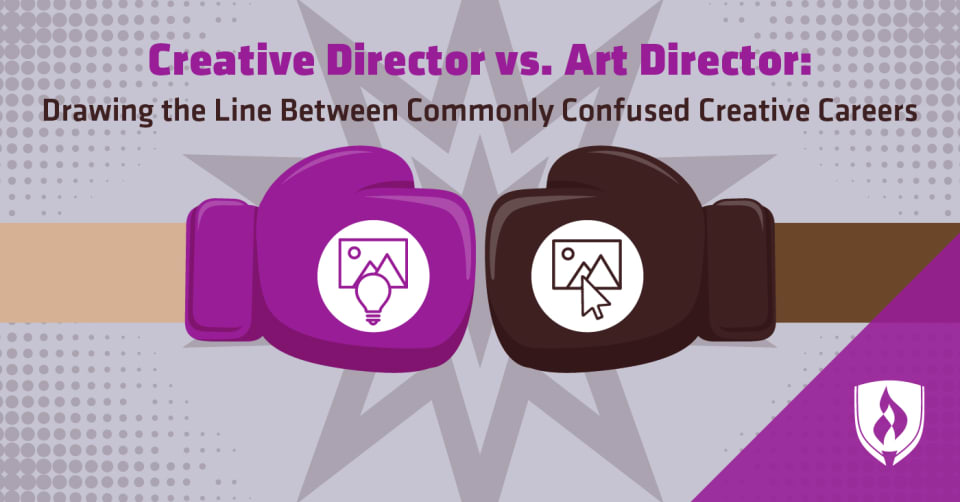Creative Director vs. Art Director: Drawing the Line Between Commonly Confused Creative Careers
By Brianna Flavin on 05/06/2019

You’ve always loved the thought of a creative career. What could be better than making the everyday things around you beautiful and visually intriguing for a living? And if you’ve done any research, you’ve likely encountered two job titles that seem very similar: creative director versus art director.
Both seem like positions that could help you leverage your creativity in a meaningful way. And you’re not wrong. The roles can be very similar in some settings. “Creative direction and art direction at small agencies will typically have a significant amount of overlap, if not being just one combination position,” says Brian Smith, creative director at FullStack Labs.
Even though the roles aren’t always totally distinct, there are some specifics associated with each career that can help you compare and contrast the duties of creative directors versus art directors.
“To any student considering becoming an art director or creative director, spend time focusing on your true talents and gifts,” says art director and brand storyteller Rachel Pesso. “The world needs you all so much.”
So how do these roles overlap and how do they differ? With the help of creative professionals, let’s take a closer look at these two roles and set the record straight.
What is a creative director?
The creative director is typically the head of the creative team. These professionals have the final say on what goes to the client and make important upper-level managerial and creative direction decisions.
Creative directors generally develop and oversee projects at the earliest stages. They cast vision, form concepts and pilot design philosophy. These are the big-picture thinkers of the team. They can close their eyes and see the finished product, even though it hasn’t been created yet. And while their focus is typically on the bigger picture of getting the work done and the direction it’ll take, that doesn’t mean an eye for detail falls to the wayside.
“Because I have the mindset of wanting to understand even the smallest piece, I’m able to look beyond the normal details others see and create something more thoughtful and impactful,” says Teal Nicholson, creative director of LLG Events.
What does a creative director do?
You’ll find the creative director in meetings with clients, heading up team brainstorming sessions and spearheading the initial concepts of a project. They map out future plans and make sure the result and process match the client’s goals and objectives. The role really centers on team management and providing creative vision.
“It’s important to realize that creative direction involves more than coming up with cool or innovative ideas,” Nicholson says. “You need to be a good leader, have fine-tuned analytical skills and be open to other people’s opinions and concepts.” This job title involves managing people—and success can hinge on your ability to adapt to your team.
It’s also important to understand an entire creation process, Nicholson adds. You’ll manage a project from start to finish, including execution. “It’s my job to clearly explain how to maintain our brand image, how to execute our design process for each event, and how to make sure everything we do is reflective of our company and our clients in tandem.”
After these parameters are clear, creative directors delegate each part of the process to their team members.
Depending on the size of the company, the creative director might get further into the nitty-gritty with the team and contribute to certain aspects of the project. Other creative directors may observe from afar and continue steering the ship, making course corrections as needed.
How do you become a creative director?
As you can see, creative directors have quite a bit of responsibility. That’s why it shouldn’t come as a surprise that in most cases you’ll need to be formally educated to join the ranks of these creative professionals.
We used job posting analysis software to analyze more than 3,000 creative director job postings from the past year and found that 90 percent of job postings are seeking candidates with a bachelor’s degree or higher.1 The most common option is earning a bachelor’s degree in Graphic Design, but some opt for degrees in advertising, fine arts or another creative field.
Education is only the first step. Unless you already have experience in related fields, you’ll likely need to work in the field to learn the ropes and start climbing the ladder. Creative director isn’t an entry-level job. According to our analysis, over 70 percent of creative director positions asked for six or more years of experience with approximately 25 percent of postings asking for candidates with three to five years under their belts.1
These years of building experience are important opportunities to understand how other roles function. Mastering skills and tools like graphic design, illustration, photography, copywriting, Adobe Creative Suite® and social media can all give you valuable insight into what needs to happen for a project to succeed.
“I learn by doing,” Nicholson says. “So I found the best way to learn best practices was to perform them myself. I wanted to try what I could to understand processes holistically, as opposed to piece by piece.”
What is an art director?
While a creative director provides the conceptual idea behind the project, the art director executes the details. Once the concept is out on the table, art directors are responsible for heading up their teams and creating the aesthetic of the piece. They see the project through the phases of production, edits and final execution. Art directors rely on their technical skills to help a team get the job done.
What does an art director do?
Leading a team of artists, art directors will determine which artistic elements to use; articulate the vision to their team; review and approve copy, designs or photography; develop budgets and timelines; and determine how to best represent the creative director’s concept.
Freelance art director Melissa Yancey emphasizes that art directors engage in multiple art forms instead of zooming in on just one. Designing, printing, making custom boxes and papier-mâché props, constructing, painting, decorating entire sets and researching tasks all fall under her role.
You can find art directors working in a vast array of fields, including advertising, on movie sets, in public relations firms, with theater and TV producers and directors, or at book and magazine publishing houses. Read more about art directors here, in "What Does an Art Director Do?".
How do you become an art director?
“My entire life has been preparing me to be an art director,” Yancey says. “I’ve always had wide and varied interests.” Her education began in areas like graphic design, painting and textile design as she tried to find the right career fit.
“When I had the chance to art direct a music video, I realized I could put all these things I love dearly, but haven’t mastered entirely, to use.”
As with creative directors, education is an important first step for anyone seeking the role of an art director. We analyzed nearly 2,500 art director job postings from the past year and found that 90 percent of employers prefer candidates to have at least a bachelor’s degree.2 Common degree options include graphic design, web design, art or animation.
Work experience as a graphic designer, editor, photographer or in another artistic occupation will help you master the technical skills you’ll need for leading a team of artists. If you’ve been there and done that, you’ll be able to direct and advise more easily. According to our analysis, most art director positions in the last year sought candidates with at least three to five years of related experience.2
Creative director vs. art director: Choosing a path
If you like the idea of creating concepts and really selling the idea behind them to key stakeholders, then creative direction will fulfill you, Smith says. “If you want the hands-on work of making your concept come to life, then art direction will be an ideal fit.”
Yancey recommends asking yourself whether you’re “big picture” or “little picture.” Big picture people who feel weighed down by the details that get something from A to B will likely prefer creative direction, Yancey says. Little picture people who love toying with the details and making an idea into a product will probably enjoy art direction more.
“Truly though, I wouldn’t recommend picking one path without having explored a few others,” Yancey says. Creative directors and art directors will both be better at their jobs when they have a wide base of experiences and interests.
The good news is that this isn’t a decision you’ll be pressured to rush into as you start a creative career. The years you’ll spend building experience in roles like graphic designer or production artist will give you plenty of exposure to what the work of both art and creative directors looks like. Use that time to pick the brains of these experienced design professionals—what do they like about the role? What’s challenging? Their experience can help guide your future career ambitions.
Capitalize on your creativity
Now you know the different roles and responsibilities of the creative director versus art director. Creative directors are the visionaries who maintain a holistic view of a project to ensure it meets the needs of the client. Art directors are responsible for the actual execution of each step in the process.
If both career descriptions of a creative director and an art director appeal to you—our experts agree, you don’t have to choose just yet! “I found that identifying and honing the skills that fulfilled me professionally was more important than deciding which title I wanted to achieve,” Smith says. “By mastering the skills you love, you will naturally evolve into one role or the other.”
The beginning of this journey is in education. As you enroll and learn the technical skills and foundational knowledge in design, visual communication and more, you will have more tools to decide on either of these coveted creative roles.
Check out the Rasmussen University School of Design to learn how a design education can provide a foundation for you to grow into these creative careers.
1Burning-Glass.com (analysis of 2,536 creative director job postings by education level, Feb. 01, 2018, and Jan. 31, 2019).
2Burning-Glass.com (analysis of 2,451 art director job postings by education level, Feb. 01, 2018, and Jan. 31, 2019).
Adobe Creative Suite is a registered trademark of Adobe Inc.
EDITOR’S NOTE: This article was originally published in 2017. It has since been updated to include information relevant to 2019.




